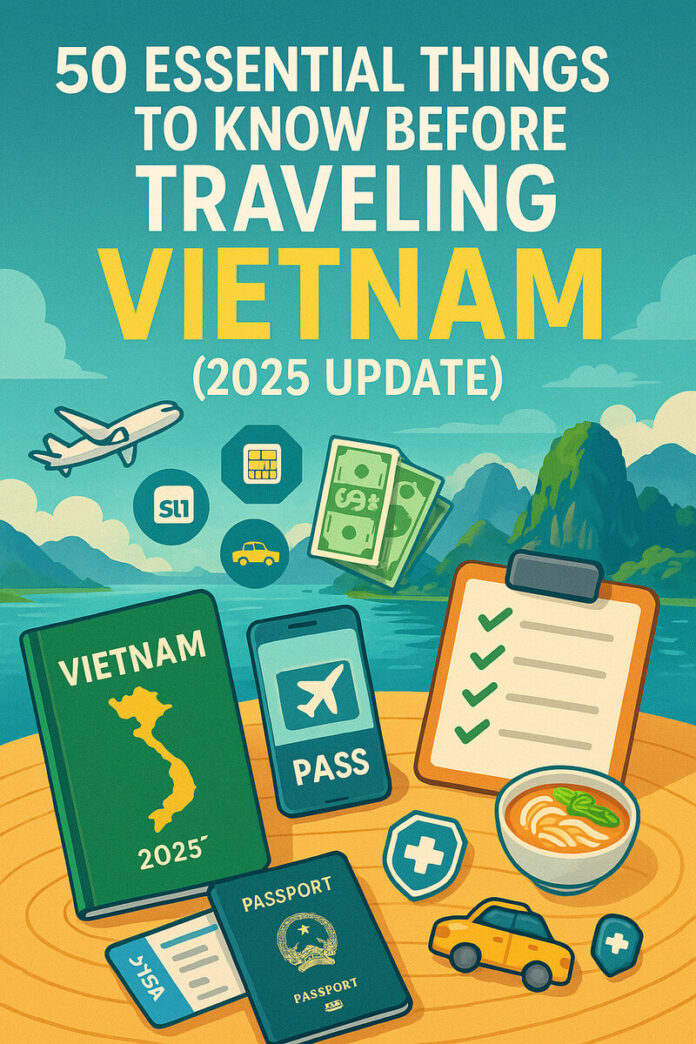Vietnam has become one of the most popular travel destinations in Asia, attracting millions of visitors every year. From bustling Hanoi and scenic Ha Long Bay to charming Hoi An and stunning Sapa, the country offers unforgettable experiences.
Before you pack your bags, here are 50 essential tips to make your trip smoother, safer, and more enjoyable.
1–10: Visa & Entry Requirements
-
Most travelers need a Vietnam visa before entering.
-
The easiest option is the Vietnam E-Visa (2025 guide).
-
E-Visa is valid for 30 days, single entry.
-
Processing time is 3–5 working days.
-
Urgent e-visa services can process in 4–24 hours.
-
Visa on Arrival is still available but less convenient.
-
Always print your e-visa before traveling.
-
Your passport must be valid for at least 6 months.
-
Make sure you select the correct entry point on your application.
-
Check country-specific requirements: Vietnam Visa by Country.
11–20: Best Time to Visit Vietnam
-
Vietnam has three main regions: North, Central, South – each with different weather.
-
Hanoi & North: best from October to April (cool & dry).
-
Central Vietnam (Hoi An, Hue, Da Nang): best from February to August.
-
South Vietnam (Saigon, Mekong): best from December to April.
-
Rainy season runs May–October (good for fewer crowds).
-
Tet Festival (Vietnamese New Year, January/February) = higher prices.
-
Avoid major holidays if you dislike crowds.
-
Best time for trekking in Sapa: September–November.
-
Best time for Ha Long Bay cruises: October–April.
-
Phu Quoc Island is best between November–March.
21–30: Money & Currency
-
Local currency: Vietnamese Dong (VND).
-
USD is accepted in some tourist areas but not everywhere.
-
ATMs are widely available in cities.
-
Bring a debit/credit card with low foreign transaction fees.
-
Cash is king for street food & markets.
-
Exchange money at banks or licensed exchange counters.
-
Avoid shady street money changers.
-
Always carry small bills (10k–50k VND).
-
Bargaining is common in markets.
-
Tipping is not mandatory but appreciated.
31–35: Internet & SIM Cards
-
Free Wi-Fi is everywhere (cafes, hotels).
-
For reliable connection, buy a local SIM card.
-
Best providers: Viettel, Mobifone, Vinaphone.
-
For convenience, try eSIM (Airalo, Holafly).
-
See full guide: Best SIM & eSIM Options for Tourists.
36–40: Transportation Tips
-
Domestic flights are cheap (Hanoi–Saigon from $40).
-
Vietnam’s Reunification Express Train is scenic but slow.
-
Sleeper buses are budget-friendly but not very comfortable.
-
Ride-hailing apps (Grab, Gojek) are safer than taxis.
-
See full guide: Vietnam Transportation Guide.
41–45: Food & Drinks
-
Must-try dishes: Pho, Bun Cha, Banh Mi, Egg Coffee.
-
Street food is safe if you choose busy stalls.
-
Avoid tap water – drink bottled or filtered water.
-
Vietnamese coffee is strong – try iced “cà phê sữa đá”.
-
Don’t miss regional specialties (Cao Lau in Hoi An, Bun Bo Hue).
46–50: Safety & Cultural Etiquette
-
Vietnam is generally safe for tourists.
-
Watch out for scams: overpriced taxis, fake tours.
-
Cross the street slowly – traffic flows around you.
-
Dress modestly when visiting temples & pagodas.
-
Learn a few basic Vietnamese phrases (Xin chào = Hello, Cảm ơn = Thank you).
Final Tips
Vietnam is a safe, affordable, and culturally rich destination. Whether you’re visiting Hanoi, cruising Ha Long Bay, exploring Hoi An, or trekking Sapa, a little preparation goes a long way.
👉 Before anything else, make sure your Vietnam Visa is ready. Apply online in 5 minutes with urgent approval: VietnamEntryVisa.com


























